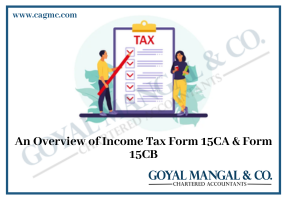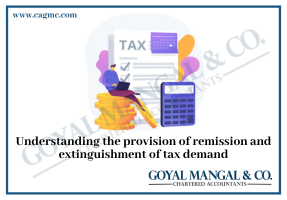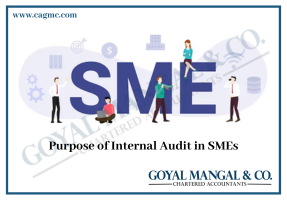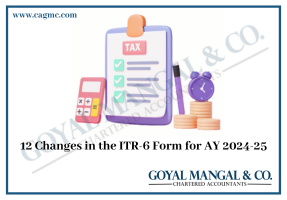 For domestic and domestic manufacturing companies that start operations on or after October 1, 2019, but before March 31, 2023, the Ministry of Finance has approved Section 115BAA and Section 115 BAB taxation law. By decreasing corporation tax rates for domestic and manufacturing enterprises, the sections were developed to help entrepreneurs. Tax on income of new domestic manufacturing businesses is covered under Section 115 BAB of the Income Tax Act, 1961, which came into effect on April 1st, 2020. A few FAQs on Section 115 BAB of the Income Tax Act, 1961 are discussed in this blog.
For domestic and domestic manufacturing companies that start operations on or after October 1, 2019, but before March 31, 2023, the Ministry of Finance has approved Section 115BAA and Section 115 BAB taxation law. By decreasing corporation tax rates for domestic and manufacturing enterprises, the sections were developed to help entrepreneurs. Tax on income of new domestic manufacturing businesses is covered under Section 115 BAB of the Income Tax Act, 1961, which came into effect on April 1st, 2020. A few FAQs on Section 115 BAB of the Income Tax Act, 1961 are discussed in this blog.
| Table of Content: |
Section 115 BAB of Income Tax Act, 1961
Section 115 BAB was first enacted by the Income Tax Act, of 1961. In order to enable domestic manufacturing firms the option of paying 15% tax, the Ministry of Finance established Section 115 BAB (Excluding Surcharge and Cess). Government rebates and incentives are no longer available to businesses that choose a lower tax rate. The Ministry of Finance gives businesses that qualify for Section 115 BAB benefits the choice of paying their taxes with or without the concessional tax.
The addition of Section 115 BAB will contribute to increased economic activity and employment opportunities. Additionally, it will support the growth of investment, output, and liquidity. The profit and disposable income of the stakeholders rise as a consequence, increasing demand, and consumption.
FAQs on Section 115 BAB
What is the Tax Rate applicable to the companies willing to pay taxes under Section 115 BAB?
If the company is planning its taxes to be paid under Section 115 BAB then:
- Companies who choose to pay tax under section 115 BAB are required to pay income tax at a rate of 15% on all last year’s income.
- No matter the overall amount of revenue, a surcharge of 10% and a health and education surcharge of 4% will also be applied.
What are the important characteristics of Section 115 BAB of the Income Tax Act, 1961?
Important characteristics of Section 115 BAB of the Income Tax Act, 1961 are:
- To encourage industrial investment and support the government’s “Make in India” strategy, the new provision section 115 BAB has been added by the Ordinance to the Income Tax Act with effect from the 2019–2020 fiscal year.
- Any domestic company that made a manufacturing investment and was established on or before October 1, 2019, has the option of paying income tax at a 15% rate under Section 115 BAB.
- Businesses that don’t qualify for any exemptions or incentives and start production before or on March 31, 2023, are eligible for the advantages under Section II5BAB.
- Additionally, these companies are excluded from the Minimum Alternate Tax (MAT).
What is the procedure for the companies to fill their Taxes under Section 115 BAB?
Form 10-ID must be submitted in order to choose Section 115 BAB on or before the deadline for filing ITR under Section 139(1).
Businesses that choose to pay tax under Section 115 BAB are unable to change their minds afterward.
What are the various factors a company needs to satisfy for paying Tax under Section 115 BAB?
The company is not created by dismantling or rebuilding an already existing company. When a business is resurrected or rebuilt for the reasons listed in and in accordance with section 33 B, this criterion does not apply. Any building that was once a hotel or convention center and for which a deduction under Section 80 ID was requested and approved is not permitted to be used by the corporation. Companies should not use any kind of second-hand machinery.
Can the new company be formed under the same name as the previous one?
The main requirements of section 115 BAB are the creation of new companies and the utilization of new equipment.
Additionally, to support the GOI’s “Make in India” drive and draw in new manufacturing investment we believe that a new company can be registered with a name that is similar to an existing one since there are no restrictions on using an existing company’s name for a new one.
What are the exceptions to the use of second-hand machinery?
If the criteria listed below are met, the aforementioned plant and machinery will not be considered previously used:
- Any machinery that was used outside India.
- Any plant imported to India from any foreign nation.
What types of operations are excluded from the definition of manufacturing for the purpose of choosing to pay tax under Section 115 BAB?
Activities mention below are not part of manufacturing as per Section 115 BAB:
- Creation of computer software in any format or through any channel
- Mining
- Transforming marble pieces or other similar objects into slabs
- Gas is bottled and put in the cylinder
- Creation of a cinematograph film or the printing of books
- Any other entity that the central government may notify
What deductions are excluded from total income calculation under Section 115 BAB?
The following are the deductions are excluded from total income calculation under Section 115 BAB:
- Section 10 AA: Deduction in respect of export turnover of units established in special economic zones
- Section 32 (1) (iia): Additional depreciation
- Section 32 AD: Investment in new plant or machinery in notified backward areas in certain States.
- Section 33 AB: Deduction on account of deposit in Tea, Coffee & Rubber development account.
- Section 33 ABA: Deduction on account of deposit in Site Restoration Fund.
- Section 35(2AB), 35(2AA), 35(1) (ii), 35(1) (iii): Deduction on account of expenditure on scientific research.
- Section 35 AD: Deduction in respect of capital expenditure on specified business
- Section 35 CCC: Deduction in respect of notified agricultural expansion project
- Section 35 CCD: Deduction in respect of notified skill development project
- Chapter VI A deductions other than section 80JJA or section 80M.
Can the previous company transfer its Trademark or Patent to a new Company?
Please take note that the requirement of Section 115 BAB in this regard is to begin new domestic manufacturing that produces a unique material or product. In order to avoid litigation and to satisfy the requirements of the section, in our opinion, the corporation must apply for a brand-new Trademark or Patent.
If one used the same trademark or patent that had previously been used by the assessee itself, it would be assumed that the assessee had not produced any new products or articles.
What is the Tax Rate on Short-Term Capital Gains?
Short-term capital gains resulting from the transfer of a capital asset on which no depreciation is permitted under the Act will be subject to income tax at a rate of 22%.
Is it possible for the director of the new and the old companies to be the same?
Before making important decisions about financing, business setup, employing staff, etc., it is advised that the board members of both companies (the old firm and the newly founded company) should be made up of separate individuals.
Takeaway
A domestic manufacturing company that satisfies the requirements listed in Sub Section of the Income Tax may benefit from section 115 BAB. An Indian company that is registered and established qualifies as a domestic manufacturer. With the 115 BAB benefit in effect, the new effective tax rate for domestic manufacturing is 17.16 percent.
In order to receive the advantage of the decreased rate of corporate tax, several requirements must be met. However, choosing to pay tax under the lower tax regime is advantageous for a company if it is in a position to fulfill and comply with such rules and limitations. When a significant capital investment in machinery is necessary, the investor or firm must carefully consider the favorable tax rate of the new provision in comparison to the additional depreciation forgone.







